Komatsu PC27MR-2, PC35MR-2 Maintenance Manual
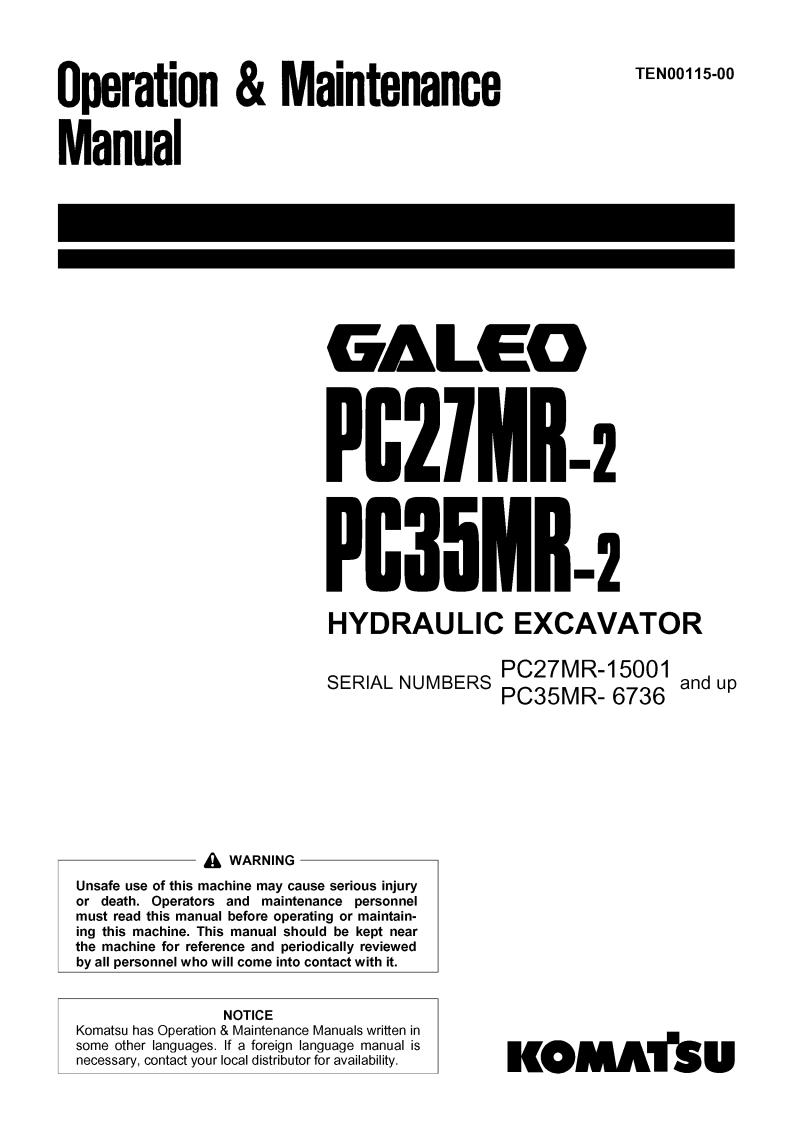
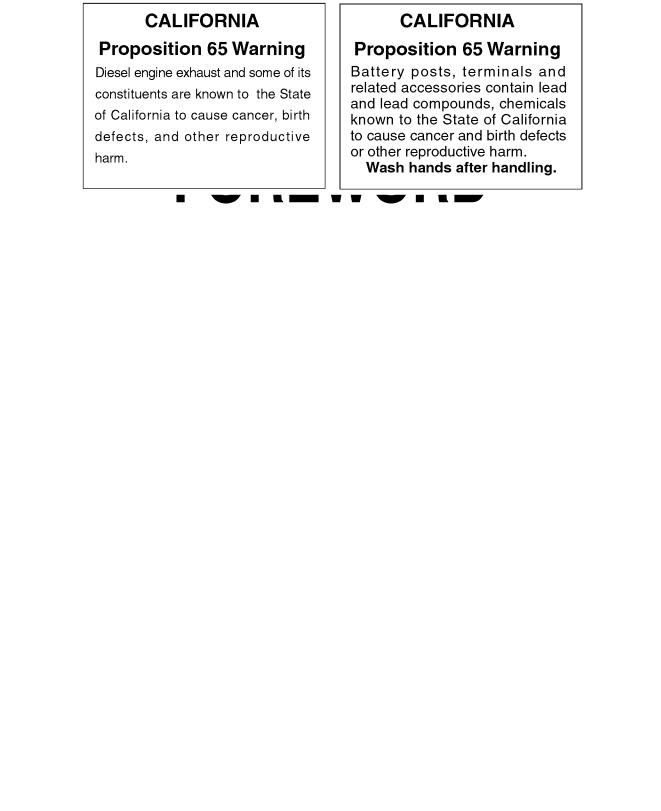
1 - 1
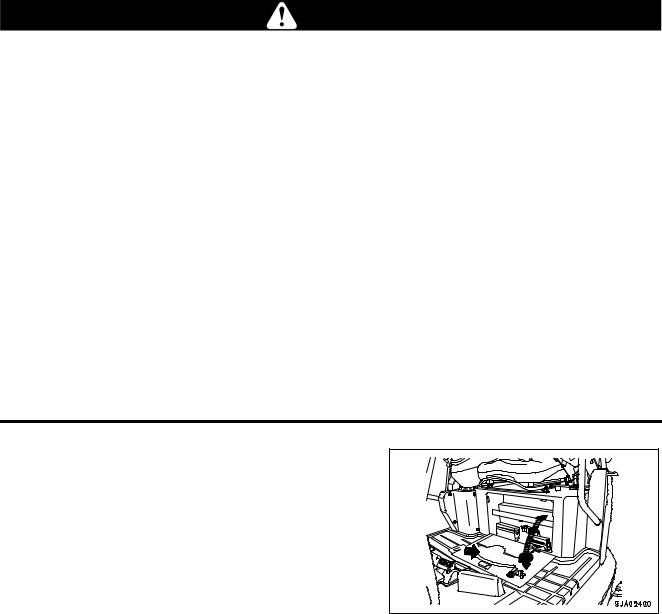
FOREWORD |
FOREWORD |
|
|
FOREWORD
This manual provides rules and guidelines which will help you use this machine safely and effectively. The precautions in this manual must be followed at all times when performing operation and maintenance. Most accidents are caused by the failure to follow fundamental safety rules for the operation and maintenance of machines. Accidents can be prevented by knowing beforehand conditions that may cause a hazard when performing operation and maintenance.
WARNING
Operators and maintenance personnel must always do as follows before beginning operation or maintenance.


 Always be sure to read and understand this manual thoroughly before performing operation and maintenance.
Always be sure to read and understand this manual thoroughly before performing operation and maintenance.


 Read the safety messages given in this manual and the safety labels affixed to the machine thoroughly and be sure that you understand them fully.
Read the safety messages given in this manual and the safety labels affixed to the machine thoroughly and be sure that you understand them fully.
Keep this manual in the storage location for the operation and maintenance manual given below, and have all personnel read it periodically.
If this manual has been lost or has become dirty and cannot be read, request a replacement manual immediately from Komatsu or your Komatsu distributor.
If you sell the machine, be sure to give this manual to the new owners together with the machine.
Komatsu delivers machines that comply with all applicable regulations and standards of the country to which it has been shipped. If this machine has been purchased in another country or purchased from someone in another country, it may lack certain safety devices and specifications that are necessary for use in your country. If there is any question about whether your product complies with the applicable standards and regulations of your country, consult Komatsu or your Komatsu distributor before operating the machine.
Storage location for the Operation and Maintenance Manual:
Pocket on inside of cover of toolbox under operator's seat
1 - 2
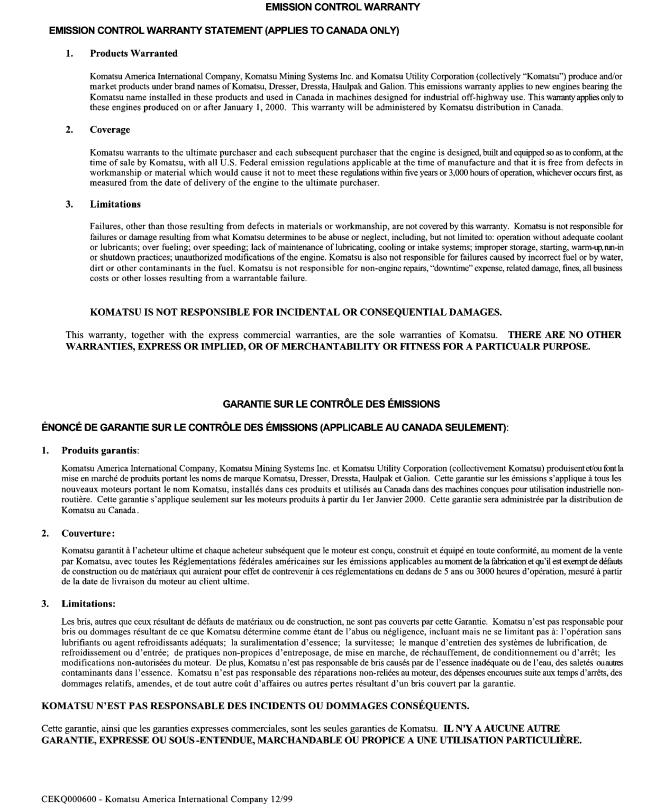
FOREWORD |
FOREWORD |
|
|
1 - 3
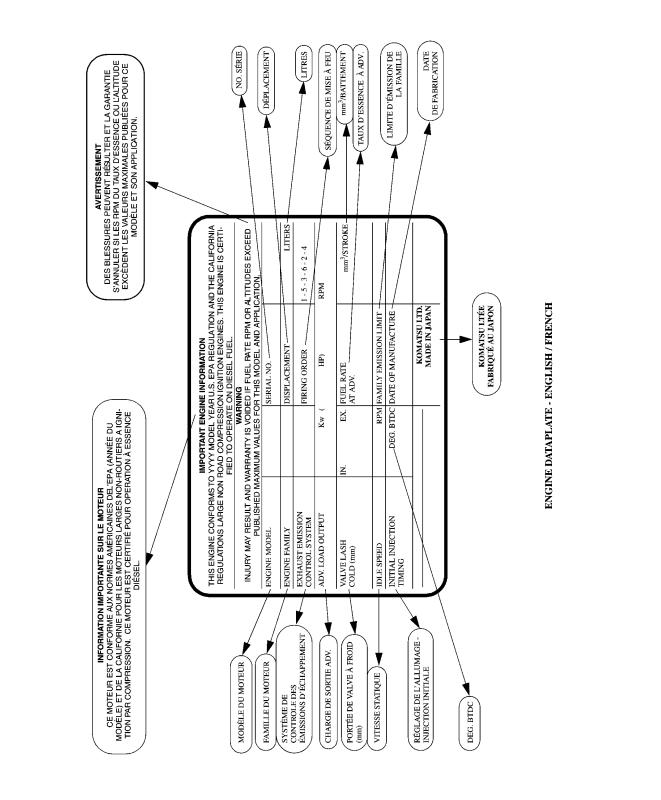
FOREWORD |
FOREWORD |
|
|
1 - 4
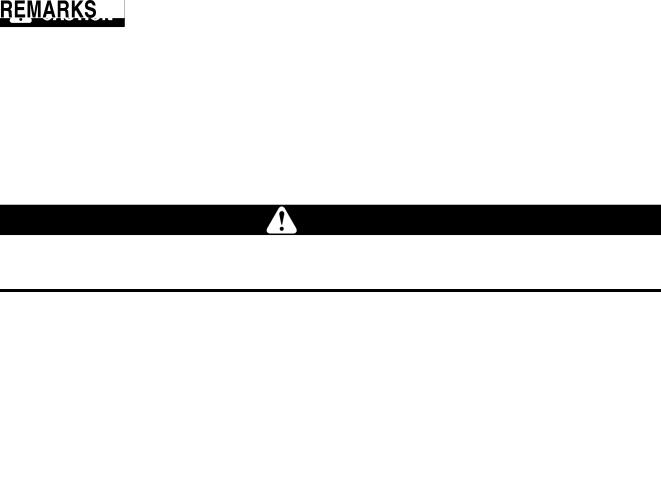
FOREWORD |
SAFETY INFORMATION |
|
|
SAFETY INFORMATION
To enable you to use this machine safely, safety precautions and labels are given in this manual and affixed to the machine to give explanations of situations involving potential hazards and of the methods of avoiding such situations.
Signal words
The following signal words are used to inform you that there is a potential hazardous situation that may lead to personal injury or damage.
In this manual and on machine labels, the following signal words are used to express the potential level of hazard.
Indicates an imminently hazardous situation which, if not avoided, will result in death or serious injury.
Indicates a potentially hazardous situation which, if not avoided, could result in death or serious injury.
Indicates a potentially hazardous situation which, if not avoided, may result in minor or moderate injury. This word is used also to alert against unsafe practices that may cause property damage.
Example of safety message using signal word
WARNING
When standing up from the operator's seat, always place the lock lever in the LOCK position.
If you accidentally touch the control levers when they are not locked, this may cause a serious injury or death.
Other signal words
In addition to the above, the following signal words are used to indicate precautions that should be followed to protect the machine or to give information that is useful to know.
This word is used for precautions that must be taken to avoid actions which could shorten the life of the machine.
This word is used for information that is useful to know.
1 - 5
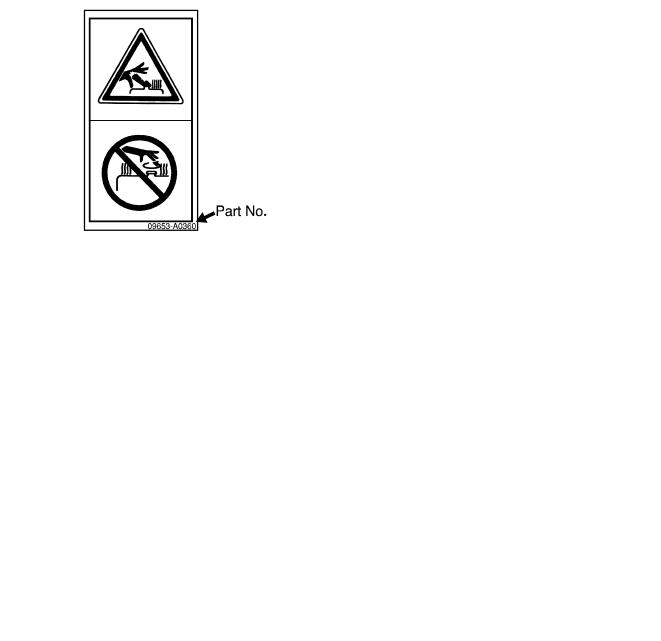
SAFETY INFORMATION |
FOREWORD |
|
|

 Safety labels
Safety labels
Safety labels are affixed to the machine to inform the operator or maintenance worker on the spot when carrying out operation or maintenance of the machine that may involve hazard.
This machine uses "Safety labels using words" and "Safety labels using pictograms" to indicate safety procedures.
Example of safety label using words
Safety labels using pictogram
Safety pictograms use a picture to express a level of hazardous condition equivalent to the signal word. These safety pictograms use pictures in order to let the operator or maintenance worker understand the level and type of hazardous condition at all times. Safety pictograms show the type of hazardous condition at the top or left side, and the method of avoiding the hazardous condition at the bottom or right side. In addition, the type of hazardous condition is displayed inside a triangle and the method of avoiding the hazardous condition is shown inside a circle.
Komatsu cannot predict every circumstance that might involve a potential hazard in operation and maintenance. Therefore, the safety messages in this manual and on the machine may not include all possible safety precautions. If any procedures or actions not specifically recommended or allowed in this manual are used, it is your responsibility to take the necessary steps to ensure safety.
In no event should you engage in prohibited uses or actions described in this manual.
The explanations, values, and illustrations in this manual were prepared based on the latest information available at that time. Continuing improvements in the design of this machine can lead to changes in detail which may not be reflected in this manual. Consult Komatsu or your Komatsu distributor for the latest available information of your machine or for questions regarding information in this manual.
The numbers in circles in the illustrations correspond to the numbers in ( ) in the text. (For example: 1 -> (1))
1 - 6
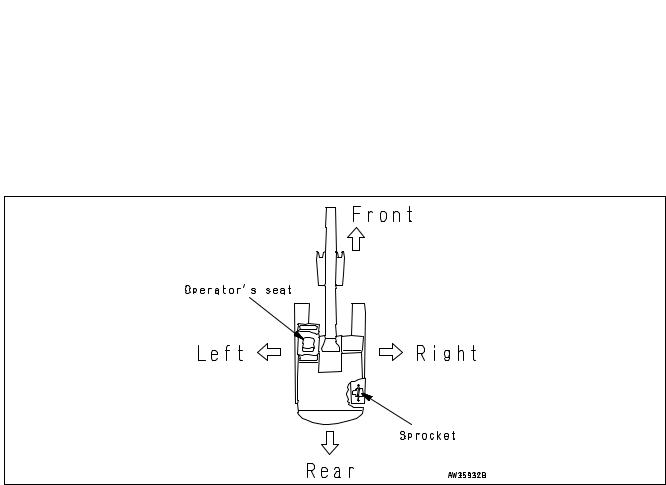
FOREWORD |
INTRODUCTION |
|
|
INTRODUCTION
This Komatsu machine is designed to be used mainly for the following work:

 Digging work
Digging work

 Leveling work
Leveling work

 Ditching work
Ditching work

 Loading work
Loading work

 Demolition work
Demolition work
See the section "WORK POSSIBLE USING COMPACT HYDRAULIC EXCAVATOR (PAGE 3-79)" for further details.
DIRECTIONS OF MACHINE
In this manual, the terms front, rear, left, and right refer to the travel direction as seen from the operator's seat when the operator's seat is facing the front and the sprocket is at the rear of the machine.
1 - 7

PRODUCT INFORMATION |
FOREWORD |
|
|
PRODUCT INFORMATION
When requesting service or ordering replacement parts, please inform your Komatsu distributor of the following items.
PRODUCT IDENTIFICATION NUMBER (PIN)/MACHINE SERIAL NO. PLATE
On the left front of the frame.
The design of the nameplate differs according to the territory.
ENGINE SERIAL NUMBER PLATE AND ITS LOCATION
This is fixed to the water separator bracket.
1 - 8
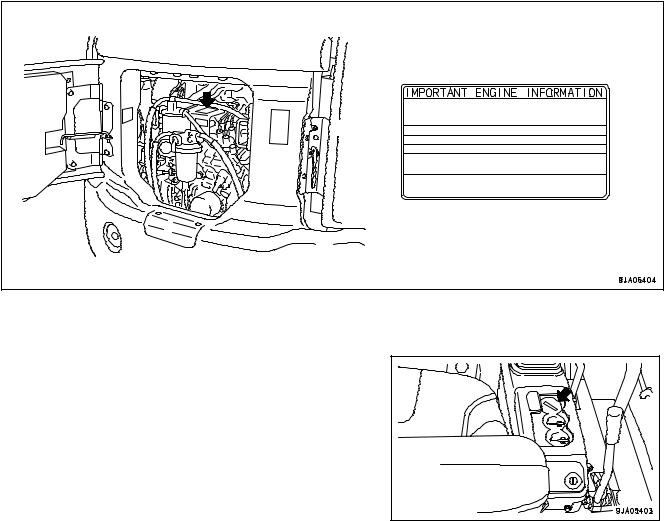
FOREWORD |
PRODUCT INFORMATION |
|
|
EMISSION CONTROL INFORMATION LABEL AND ITS LOCATION
This is fixed on top of the water separator bracket.
EPA: Environmental Protection Agency, U.S.A.
SERVICE METER LOCATION
On top of the machine monitor
1 - 9
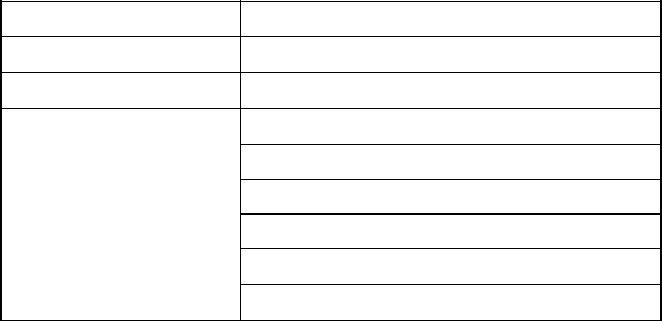
PRODUCT INFORMATION |
FOREWORD |
|
|
YOUR MACHINE SERIAL NUMBERS AND DISTRIBUTOR
Machine serial No.
Engine serial No.
Product identification number (PIN)
Distributor name
Address
Service Personnel
Phone/Fax
1 - 10

FOREWORD CONTENTS
CONTENTS
FOREWORD |
1- |
1 |
FOREWORD |
1- |
2 |
SAFETY INFORMATION |
1- |
5 |
INTRODUCTION |
1- |
7 |
DIRECTIONS OF MACHINE |
1- |
7 |
PRODUCT INFORMATION |
1- |
8 |
PRODUCT IDENTIFICATION NUMBER (PIN)/MACHINE SERIAL NO. PLATE |
1- |
8 |
ENGINE SERIAL NUMBER PLATE AND ITS LOCATION |
1- |
8 |
EMISSION CONTROL INFORMATION LABEL AND ITS LOCATION |
1- |
9 |
SERVICE METER LOCATION |
1- |
9 |
YOUR MACHINE SERIAL NUMBERS AND DISTRIBUTOR |
1- 10 |
|
SAFETY |
2- |
1 |
SAFETY INFORMATION |
2- |
2 |
SAFETY LABELS |
2- |
4 |
LOCATION OF SAFETY LABELS |
2- |
4 |
SAFETY LABELS |
2- |
5 |
SAFETY INFORMATION |
2- 10 |
|
SAFETY MACHINE OPERATION |
2- 19 |
|
STARTING ENGINE |
2- 19 |
|
OPERATION |
2- 21 |
|
TRANSPORTATION |
2- 27 |
|
BATTERY |
2- 28 |
|
TOWING |
2- 30 |
|
LIFTING OBJECTS WITH BUCKET |
2- 31 |
|
SAFETY MAINTENANCE INFORMATION |
2- 32 |
|
OPERATION |
3- |
1 |
MACHINE VIEW ILLUSTRATIONS |
3- |
2 |
OVERALL MACHINE VIEW |
3- |
2 |
CONTROLS AND GAUGES |
3- |
3 |
DETAILED CONTROLS AND GAUGES |
3- |
4 |
MONITORING SYSTEM |
3- |
4 |
SWITCHES |
3- 12 |
|
CONTROL LEVERS AND PEDALS |
3- 16 |
|
WINDSHIELD |
3- 22 |
|
SLIDING DOOR |
3- 26 |
|
SLIDING WINDOW |
3- 26 |
|
EMERGENCY ESCAPE HAMMER |
3- 27 |
|
COVER WITH LOCK |
3- 28 |
|
ENGINE REAR COVER |
3- 29 |
|
COOLING COVER |
3- 29 |
|
MUD COVER |
3- 30 |
|
METHOD OF OPENING (TILTING) FLOOR |
3- 31 |
|
FUSE |
3- 36 |
|
BLOCK FUSE |
3- 37 |
|
OPERATION MANUAL STORAGE |
3- 38 |
|
TOOL BOX |
3- 38 |
|
GREASE GUN HOLDER |
3- 38 |
|
ASHTRAY |
3- 38 |
|
MACHINE OPERATIONS AND CONTROLS |
3- 39 |
|
1 - 11

CONTENTS |
FOREWORD |
|
|
BEFORE STARTING ENGINE |
3- 39 |
|
STARTING ENGINE |
3- 54 |
|
AFTER STARTING ENGINE |
3- 58 |
|
STOPPING THE ENGINE |
3- 61 |
|
MACHINE OPERATION |
3- 62 |
|
STEERING THE MACHINE |
3- 67 |
|
SWINGING |
3- 69 |
|
WORK EQUIPMENT CONTROLS AND OPERATIONS |
3- 70 |
|
PROHIBITED OPERATIONS |
3- 72 |
|
GENERAL OPERATION INFORMATION |
3- 74 |
|
TRAVELING ON SLOPES |
3- 76 |
|
ESCAPE FROM MUD |
3- 78 |
|
WORK POSSIBLE USING COMPACT HYDRAULIC EXCAVATOR |
3- 79 |
|
BUCKET REPLACEMENT |
3- 81 |
|
PARKING MACHINE |
3- 82 |
|
MACHINE INSPECTION AFTER DAILY WORK |
3- 83 |
|
LOCKING |
3- 84 |
|
RUBBER SHOES AND ROAD LINERS |
3- 85 |
|
TRANSPORTATION |
3- 90 |
|
TRANSPORTATION PROCEDURE |
3- 90 |
|
LOADING AND UNLOADING WITH TRAILER |
3- 91 |
|
LIFTING MACHINE |
3- 97 |
|
COLD WEATHER OPERATION |
3-100 |
|
COLD WEATHER OPERATION INFORMATION |
3-100 |
|
CAB HEATER IN COLD WEATHER |
3-101 |
|
AFTER DAILY WORK COMPLETION |
3-102 |
|
AFTER COLD WEATHER SEASON |
3-102 |
|
LONG TERM STORAGE |
3-103 |
|
BEFORE STORAGE |
3-103 |
|
DURING STORAGE |
3-104 |
|
AFTER STORAGE |
3-104 |
|
TROUBLES AND ACTIONS |
3-105 |
|
RUNNING OUT OF FUEL |
3-105 |
|
PHENOMENA THAT ARE NOT FAILURES |
3-105 |
|
TOWING THE MACHINE |
3-106 |
|
SEVERE JOB CONDITION |
3-106 |
|
DISCHARGED BATTERY |
3-107 |
|
OTHER TROUBLE |
3-111 |
|
MAINTENANCE |
4- |
1 |
MAINTENANCE INFORMATION |
4- |
2 |
OUTLINE OF SERVICE |
4- |
4 |
HANDLING OIL, FUEL, COOLANT, AND PERFORMING OIL CLINIC |
4- |
4 |
ELECTRIC SYSTEM MAINTENANCE |
4- |
7 |
HANDLING HYDRAULIC SYSTEM |
4- |
7 |
WEAR PARTS |
4- |
8 |
WEAR PARTS LIST |
4- |
8 |
LUBRICANTS, FUEL AND COOLANT SPECIFICATIONS |
4- |
9 |
TIGHTENING TORQUE SPECIFICATIONS |
4- 13 |
|
TIGHTENING TORQUE LIST |
4- 13 |
|
SAFETY CRITICAL PARTS |
4- 14 |
|
1 - 12

FOREWORD |
CONTENTS |
|
|
SAFETY CRITICAL PARTS LIST |
4- 14 |
|
MAINTENANCE SCHEDULE |
4- 15 |
|
MAINTENANCE SCHEDULE CHART |
4- 15 |
|
MAINTENANCE INTERVAL FOR HYDRAULIC BREAKER |
4- 16 |
|
MAINTENANCE PROCEDURE |
4- 17 |
|
WHEN REQUIRED |
4- 17 |
|
CHECK BEFORE STARTING |
4- 44 |
|
EVERY 500 HOURS MAINTENANCE |
4- 45 |
|
EVERY 1000 HOURS MAINTENANCE |
4- 54 |
|
EVERY 2000 HOURS MAINTENANCE |
4- 56 |
|
SPECIFICATIONS |
5- |
1 |
SPECIFICATIONS |
5- |
2 |
ATTACHMENTS AND OPTIONS |
6- |
1 |
ATTACHMENTS AND OPTIONS - GENERAL INFORMATION |
6- |
2 |
SAFETY FIRST |
6- |
2 |
ATTACHMENT INSTALLATION |
6- |
3 |
BUCKET WITH HOOK |
6- |
4 |
PROHIBITED OPERATIONS |
6- |
4 |
AIR CONDITIONER |
6- |
5 |
CONTROL PANEL AND COMPONENTS |
6- |
5 |
AIR CONDITIONER CONTROLS |
6- |
6 |
AIR CONDITIONER MAINTENANCE |
6- |
7 |
WINDSHIELD WASHER |
6- 11 |
|
WINDSHIELD WASHER OPERATION |
6- 11 |
|
CHECK WINDOW WASHER FLUID LEVEL, ADD FLUID |
6- 11 |
|
MACHINE READY FOR ATTACHMENT |
6- 12 |
|
LOCATIONS |
6- 12 |
|
HYDRAULIC CIRCUIT |
6- 14 |
|
ATTACHMENT OPERATIONS |
6- 16 |
|
LONG TERM STORAGE |
6- 17 |
|
SPECIFICATIONS |
6- 17 |
|
CHANGING MACHINE CONTROL PATTERN (IF PATTERN CHANGE VALVE EQUIPPED) |
6- 18 |
|
CONTROL PATTERN CHANGE PROCEDURE |
6- 18 |
|
MACHINE CONTROL PATTERNS |
6- 19 |
|
POWER ANGLE BLADE |
6- 20 |
|
BLADE CONTROL LEVER |
6- 20 |
|
WHEN REQUIRED |
6- 21 |
|
EVERY 500 HOURS SERVICE |
6- 21 |
|
WEAR PARTS LIST |
6- 22 |
|
SPECIFICATIONS |
6- 22 |
|
ATTACHMENT GUIDE |
6- 23 |
|
ATTACHMENT COMBINATIONS |
6- 23 |
|
RECOMMENDED ATTACHMENT OPERATIONS |
6- 24 |
|
HYDRAULIC BREAKER |
6- 24 |
|
HIGH-ALTITUDE SPECIFICATION MACHINE |
7- |
1 |
LOCATIONS |
7- |
2 |
MAINTENANCE PROCEDURE |
7- |
3 |
EVERY 2000 HOURS MAINTENANCE |
7- |
3 |
SPECIFICATIONS |
7- |
4 |
INDEX |
8- |
1 |
1 - 13

2 - 1
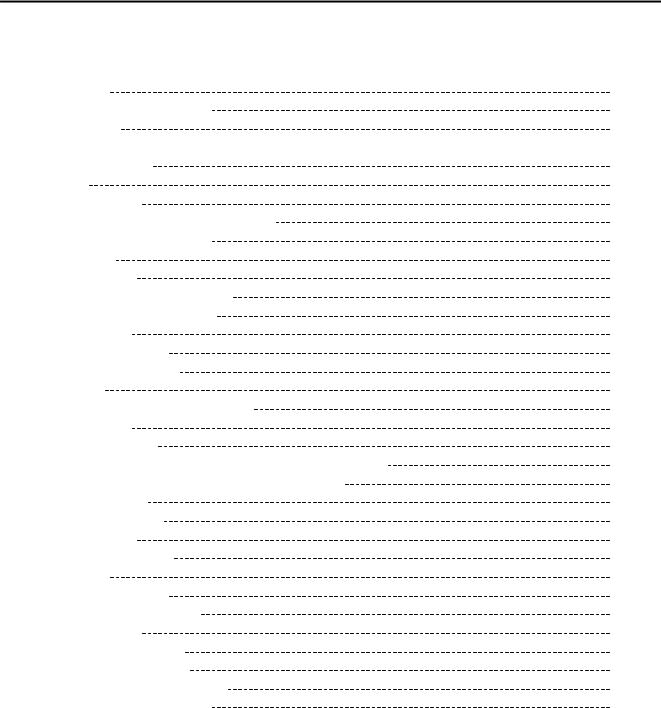
SAFETY INFORMATION SAFETY
SAFETY INFORMATION
SAFETY LABELS |
2- |
4 |
LOCATION OF SAFETY LABELS |
2- |
4 |
SAFETY LABELS |
2- |
5 |
SAFETY INFORMATION |
2- 10 |
|
Safety Rules |
2- |
10 |
If Problems are Found |
2- 10 |
|
Working Wear and Personal Protective Items |
2- 10 |
|
Fire Extinguisher and First Aid Kit |
2- |
10 |
Safety Equipment |
2- 11 |
|
Keep Machine Clean |
2- 11 |
|
Keep Operator's Compartment Clean |
2- 11 |
|
Leaving Operator's Seat with Lock |
2- |
11 |
Handrails and Steps |
2- 12 |
|
Mounting and Dismounting |
2- 12 |
|
No Persons on Attachments |
2- 12 |
|
Burn Prevention |
2- |
13 |
Fire Prevention and Explosion Prevention |
2- |
13 |
Action if Fire Occurs |
2- |
14 |
Windshield Washer Fluid |
2- 14 |
|
Falling Objects, Flying Objects and Intruding Objects Prevention |
2- |
15 |
Cautions Related to ROPS (Rollover Protection System) |
2- |
15 |
Attachment Installation |
2- |
16 |
Attachment Combinations |
2- 16 |
|
Cab Window Glasses |
2- 16 |
|
Unauthorized Modifications |
2- |
16 |
Safety at Jobsite |
2- |
16 |
Working on Loose Ground |
2- 16 |
|
Distance to High Voltage Cables |
2- |
17 |
Ensure Good Visibility |
2- |
17 |
Ventilation for Enclosed Area |
2- |
17 |
Signalman's Signal and Signs |
2- |
18 |
Emergency Exit from Operator's Cab |
2- 18 |
|
Asbestos Dust Hazard Prevention |
2- 18 |
|
2 - 2

SAFETY |
SAFETY INFORMATION |
|
|
SAFETY MACHINE OPERATION |
2- 19 |
|
STARTING ENGINE |
2- 19 |
|
Checks Before Starting Engine |
2- |
19 |
Safety Rules for Starting Engine |
2- |
20 |
Starting Engine in Cold Weather |
2- |
20 |
OPERATION |
2- 21 |
|
Checks Before Operation |
2- 21 |
|
Safety Rules for Changing Machine Directions |
2- |
21 |
Safety Rules for Traveling |
2- |
22 |
Traveling on Slopes |
2- |
23 |
Operations on Slopes |
2- 24 |
|
Prohibited Operations |
2- |
24 |
Operations on Snow |
2- 26 |
|
Parking Machine |
2- 26 |
|
TRANSPORTATION |
2- 27 |
|
Loading and Unloading |
2- 27 |
|
Shipping the Machine |
2- 27 |
|
BATTERY |
2- 28 |
|
Battery Hazard Prevention |
2- |
28 |
Starting Engine with Booster Cables |
2- |
29 |
TOWING |
2- 30 |
|
Safety Rules for Towing |
2- |
30 |
LIFTING OBJECTS WITH BUCKET |
2- 31 |
|
Safety Rules for Lifting Objects |
2- |
31 |
SAFETY MAINTENANCE INFORMATION |
2- 32 |
|
Warning Tag |
2- 32 |
|
Keep Work Place Clean and Tidy |
2- 32 |
|
Appoint Leader when Working with Others |
2- 32 |
|
Stop Engine Before Carrying Out Maintenance |
2- 33 |
|
Cautions for Opening (Tilting) Floor |
2- |
34 |
Two Workers for Maintenance when Engine is Running |
2- 35 |
|
Proper Tools |
2- |
35 |
Personnel |
2- 35 |
|
Attachments |
2- 36 |
|
Work Under the Machine |
2- 36 |
|
Noise |
2- 36 |
|
When Using Hammer |
2- 36 |
|
Welding Works |
2- 36 |
|
Removing Battery Terminals |
2- 37 |
|
Safety First when Using High-pressure Grease to Adjust Track Tension |
2- |
37 |
Do not Disassemble Recoil Springs |
2- 37 |
|
Safety Rules for High-pressure Oil |
2- |
37 |
Safety Handling High-pressure Hoses |
2- 38 |
|
Waste Materials |
2- |
38 |
Air Conditioner Maintenance |
2- |
38 |
Compressed Air |
2- 38 |
|
Periodic Replacement of Safety Critical Parts |
2- |
38 |
2 - 3
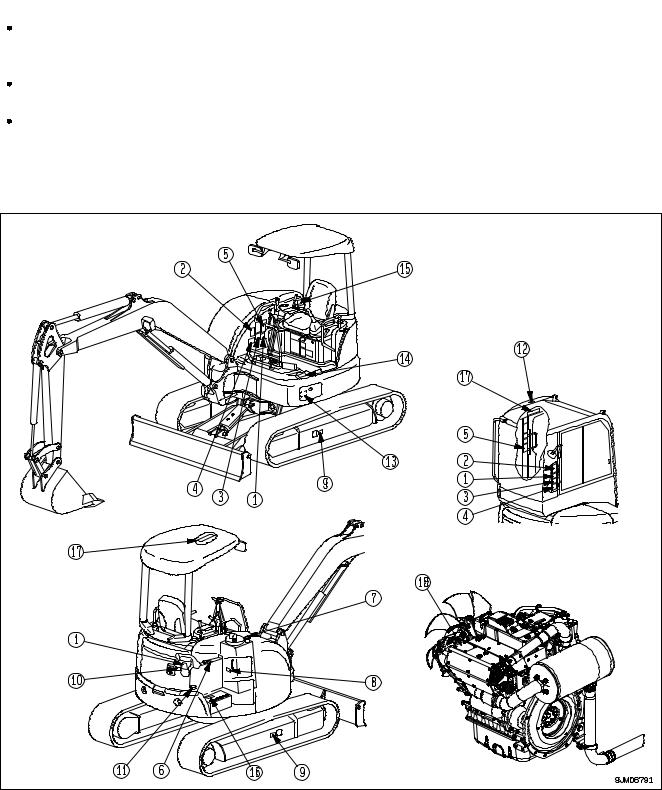
SAFETY LABELS |
SAFETY |
|
|
SAFETY LABELS
The following warning signs and safety labels are used on this machine.


 Be sure that you fully understand the correct position and content of labels.
Be sure that you fully understand the correct position and content of labels.
To ensure that the content of labels can be read properly, be sure that they are in the correct place and always keep them clean. When cleaning them, do not use organic solvents or gasoline. These may cause the labels to peel off.
There are also other labels in addition to the warning signs and safety labels. Handle those labels in the same way.
If the labels are damaged, lost, or cannot be read properly, replace them with new ones. For details of the part numbers for the labels, see this manual or the actual label, and place an order with Komatsu distributor.
LOCATION OF SAFETY LABELS
2 - 4 |

SAFETY |
SAFETY LABELS |
|
|
SAFETY LABELS
(1)Caution before operating or maintaining machine (09651-03001)
(2) Caution for before operation (22L-98-22160)
(3) Warning for leaving operator's seat (09654-03001)
2 - 5

SAFETY LABELS |
SAFETY |
|
|
(4) Warnings for high voltage (09801-03001)
(5) Caution for operating pattern (22J-98-1A631)
(6) Caution for high-temperature coolant (20M-98-83250)
2 - 6

SAFETY |
SAFETY LABELS |
|
|
(7) Caution for high-temperature hydraulic oil (22L-98-22240)
(8) Caution for handling electric wires (09808-03000)
(9) Caution for check and adjust track tention (09657-03003)
(10) Caution when opening while engine is running (09667-03001)
2 - 7

SAFETY LABELS |
SAFETY |
|
|
(11) Prohibited to enter range of swing (20M-98-73130)
(12)Caution for stowage (09803-03000) (Machines equipped with cab)
(13) Caution when changing operating pattern (22L-98-22311)
(14) Caution for lock pin when opening floor (22L-98-22390)
(15) Caution when closing floor (22L-98-22410)
2 - 8
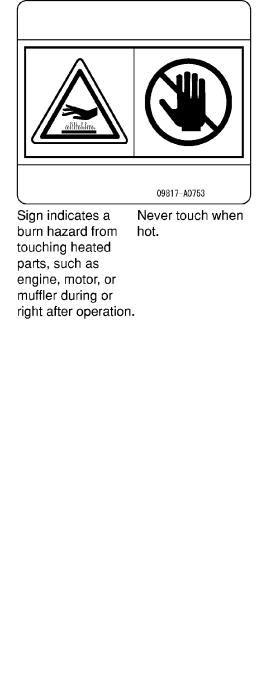
SAFETY |
SAFETY LABELS |
|
|
(16) Caution for handling battery (09664-30002)
(17) Caution for handling ROPS (22L-98-22321)
(18)Caution with high-temperature parts (09817-A0753) (High-altitude specification machine)
2 - 9

SAFETY INFORMATION SAFETY
SAFETY INFORMATION
SAFETY RULES

 Only trained and authorized personnel can operate and maintain the machine.
Only trained and authorized personnel can operate and maintain the machine.

 Follow all safety rules, precautions and instructions when operating or performing maintenance on the machine.
Follow all safety rules, precautions and instructions when operating or performing maintenance on the machine.

 If you are under the influence of alcohol or medication, your ability to safely operate or repair your machine may be severly impaired putting yourself and everyone else on your jobsite in danger.
If you are under the influence of alcohol or medication, your ability to safely operate or repair your machine may be severly impaired putting yourself and everyone else on your jobsite in danger.

 When working with another operator or with a person on worksite traffic duty, be sure that all personnel understand all hand signals that are to be used.
When working with another operator or with a person on worksite traffic duty, be sure that all personnel understand all hand signals that are to be used.
IF PROBLEMS ARE FOUND
If you find any problems in the machine during operation or maintenance (noise, vibration, smell, incorrect gauges, smoke, oil leakage, etc., or any abnormal display on the warning devices or monitor), report to the person in charge and have the necessary action taken. Do not operate the machine until the problem has been corrected.
WORKING WEAR AND PERSONAL PROTECTIVE ITEMS

 Do not wear loose clothing and accessories. There is a hazard that they may catch on control levers or other protruding parts.
Do not wear loose clothing and accessories. There is a hazard that they may catch on control levers or other protruding parts.

 If you have long hair and it hangs out from your hard hat, there is a hazard that it may get caught up in the machine, so tie your hair up and be careful not to let it get caught.
If you have long hair and it hangs out from your hard hat, there is a hazard that it may get caught up in the machine, so tie your hair up and be careful not to let it get caught.

 Always wear a hard hat and safety shoes. If the nature of the
Always wear a hard hat and safety shoes. If the nature of the
work requires it, wear safety glasses, mask, gloves, ear plugs, and safety belt when operating or maintaining the machine.

 Check that all protective equipment functions properly before
Check that all protective equipment functions properly before
using it.
FIRE EXTINGUISHER AND FIRST AID KIT
Always follow the precautions below to prepare for action if any injury or fire should occur.
 Be sure that fire extinguishers have been provided and read the labels to ensure that you know how to use them in emergencies.
Be sure that fire extinguishers have been provided and read the labels to ensure that you know how to use them in emergencies.
 Carry out periodic inspection and maintenance to ensure that the fire extinguisher can always be used.
Carry out periodic inspection and maintenance to ensure that the fire extinguisher can always be used.
 Provide a first aid kit in the storage point. Carry out periodic checks and add to the contents if necessary.
Provide a first aid kit in the storage point. Carry out periodic checks and add to the contents if necessary.
2 - 10
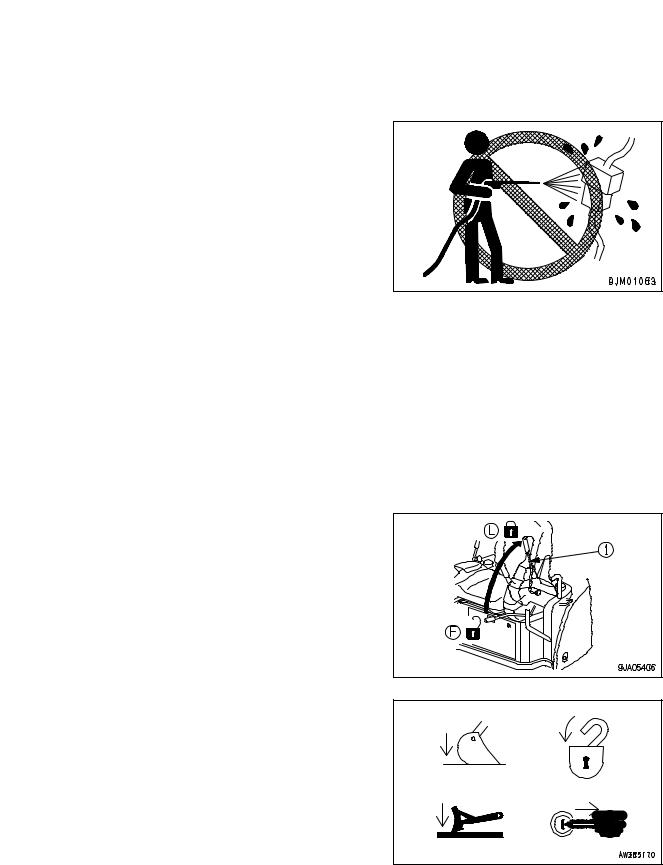
SAFETY |
SAFETY INFORMATION |
|
|
SAFETY EQUIPMENT

 Be sure that all guards and covers are in their proper position. Have guards and covers repaired immediately if they are damaged.
Be sure that all guards and covers are in their proper position. Have guards and covers repaired immediately if they are damaged.

 Understand the method of use of safety features and use them properly.
Understand the method of use of safety features and use them properly.

 Never remove any safety features. Always keep them in good operating condition.
Never remove any safety features. Always keep them in good operating condition.
KEEP MACHINE CLEAN

 If water gets into the electrical system, there is a hazard that it will cause malfunctions or misoperation. Do not use water or steam to wash the electrical system (sensors, alternator, starting motor, solenoid valves, connectors).
If water gets into the electrical system, there is a hazard that it will cause malfunctions or misoperation. Do not use water or steam to wash the electrical system (sensors, alternator, starting motor, solenoid valves, connectors).

 If inspection and maintenance is carried out when the machine is still dirty with mud or oil, there is a hazard that you will slip and fall, or that dirt or mud will get into your eyes. Always keep the machine clean.
If inspection and maintenance is carried out when the machine is still dirty with mud or oil, there is a hazard that you will slip and fall, or that dirt or mud will get into your eyes. Always keep the machine clean.

 When washing the machine with the floor open (tilted), cover with vinyl to prevent water from getting into the electrical system.
When washing the machine with the floor open (tilted), cover with vinyl to prevent water from getting into the electrical system.
KEEP OPERATOR'S COMPARTMENT CLEAN
 When entering the operator's compartment, always remove all mud and oil from the soles of your shoes.
When entering the operator's compartment, always remove all mud and oil from the soles of your shoes.
If you operate the pedal with mud or oil affixed to your shoes, your foot may slip and this may cause a serious accident.
 Do not leave parts or tools lying around the operator's compartment.
Do not leave parts or tools lying around the operator's compartment.
 Do not stick suction pads to the window glass. Suction pads act as a lens and may cause fire.
Do not stick suction pads to the window glass. Suction pads act as a lens and may cause fire.
 Do not use cellular telephones inside the operator's compartment when driving or operating the machine.
Do not use cellular telephones inside the operator's compartment when driving or operating the machine.  Never bring any dangerous objects such as flammable or explosive items into the operator's compartment.
Never bring any dangerous objects such as flammable or explosive items into the operator's compartment.
LEAVING OPERATOR'S SEAT WITH LOCK
 Before standing up from the operator's seat (such as when
Before standing up from the operator's seat (such as when
opening or closing the front window or roof window, or when removing or installing the bottom window, or when adjusting the
operator's seat), lower the work equipment completely to the ground, set lock lever (1) securely to the LOCK position (L), then stop the engine. If you accidentally touch the levers when they are not locked, there is a hazard that the machine may suddenly move and cause serious injury or property damage.
 When leaving the machine, always lower the work equipment and blade completely to the ground, set lock lever (1) to LOCK position (L), then stop the engine. Use the key to lock all the equipment. Always remove the key, take it with you, and keep it in the specified place.
When leaving the machine, always lower the work equipment and blade completely to the ground, set lock lever (1) to LOCK position (L), then stop the engine. Use the key to lock all the equipment. Always remove the key, take it with you, and keep it in the specified place.
2 - 11

SAFETY INFORMATION |
SAFETY |
|
|
HANDRAILS AND STEPS
To prevent personal injury caused by slipping or falling off the machine, always do as follows. 
 Use the handrails and steps marked by arrows in the diagram on
Use the handrails and steps marked by arrows in the diagram on
the right when getting on or off the machine.
 machine equipped with cab
machine equipped with cab
 To ensure safety, always face the machine and maintain three-point contact (both feet and one hand, or both hands and
To ensure safety, always face the machine and maintain three-point contact (both feet and one hand, or both hands and
one foot) with the handrails and steps (including the track shoe) to ensure that you support yourself.
 Do not grip the control levers, or lock lever when getting on or off the machine.
Do not grip the control levers, or lock lever when getting on or off the machine.
 Never climb on the engine hood or covers where there are no
Never climb on the engine hood or covers where there are no
non-slip pads.  Before getting on or off the machine, check the handrails and
Before getting on or off the machine, check the handrails and
steps (including the track shoe). If there is any oil, grease, or mud on the handrails or steps (including the track shoe), wipe it off immediately. Always keep these parts clean. Repair any damage and tighten any loose bolts.
 Do not get on or off the machine while holding tools in your hand.
Do not get on or off the machine while holding tools in your hand.
MOUNTING AND DISMOUNTING
 Never jump on or off the machine. Never get on or off a moving machine.
Never jump on or off the machine. Never get on or off a moving machine.
 If the machine starts to move when there is no operator on the machine, do not jump on to the machine and try to stop it.
If the machine starts to move when there is no operator on the machine, do not jump on to the machine and try to stop it.
NO PERSONS ON ATTACHMENTS
Never let anyone ride on the work equipment, or other attachments. There is a hazard of falling and suffering serious injury.
2 - 12

SAFETY |
SAFETY INFORMATION |
|
|
BURN PREVENTION
Hot coolant


 To prevent burns from hot water or steam spurting out when checking or draining the coolant, wait for the water to cool to a temperature where it is possible to touch the radiator cap by hand before starting the operation. Even when the coolant has cooled down, loosen the cap slowly to relieve the pressure inside the radiator before removing the cap.
To prevent burns from hot water or steam spurting out when checking or draining the coolant, wait for the water to cool to a temperature where it is possible to touch the radiator cap by hand before starting the operation. Even when the coolant has cooled down, loosen the cap slowly to relieve the pressure inside the radiator before removing the cap.
Hot oil
To prevent burns from hot oil spurting out when checking or draining the oil, wait for the oil to cool to a temperature where it is possible to touch the cap or plug by hand before starting the operation. Even when the oil has cooled down, loosen the cap or plug slowly to relieve the internal pressure before removing the cap or plug.
FIRE PREVENTION AND EXPLOSION PREVENTION
 Fire caused by fuel or oil
Fire caused by fuel or oil
Fuel, oil, antifreeze, and window washer liquid are particularly flammable and can be hazardous. To prevent fire, always observe the following:


 Do not smoke or use any flame near fuel or oil.
Do not smoke or use any flame near fuel or oil.
Stop the engine before refueling.
Do not leave the machine while adding fuel or oil.
Tighten all fuel and oil caps securely.
Do not spill fuel on overheated surfaces or on parts of the electrical system.
Use well-ventilated areas for adding or storing oil and fuel.
Keep oil and fuel in the determined place and do not allow unauthorized persons to enter.
After adding fuel or oil, wipe up any spilled fuel or oil.
When carrying out grinding or welding work on the chassis,
move any flammable materials to a safe place before starting.
When washing parts with oil, use a non-flammable oil. Diesel
oil and gasoline may catch fire, so do not use them.
Put greasy rags and other flammable materials into a safe container to maintain safety at the work place.
Do not weld or use a cutting torch to cut any pipes or tubes that contain flammable liquids.
2 - 13

SAFETY INFORMATION |
SAFETY |
|
|

 Fire caused by accumulated flammable material
Fire caused by accumulated flammable material
Remove any accumulated flammable material, such as dry leaves, chips, pieces of paper, and coal dust from inside the undercover or around the engine exhaust manifold, muffler, or battery. Remove also any chlorides accumulated on top of the battery or around the terminals.

 Fire starting from electric wiring
Fire starting from electric wiring
There is danger of fire caused by short circuits in the electrical system.


 Clean all the connections of the electric wiring and tighten them securely.
Clean all the connections of the electric wiring and tighten them securely.
Check every day for any loose or damaged wiring. Tighten any loose connectors or wiring clamps, and repair or replace any damaged wiring.
Remove any chlorides accumulated on the battery terminals. If the terminals are not cleaned, there is danger of fire.
 Fire coming from hydraulic line
Fire coming from hydraulic line
Check that all the hose and tube clamps, guards, and cushions are securely fixed in position.
If they are loose, they may vibrate during operation and rub against other parts. This may lead to damage to the hoses, and cause high-pressure oil to spurt out, leading to fire damage or serious injury.
 Explosion caused by lighting equipment
Explosion caused by lighting equipment
When checking fuel, oil, battery electrolyte, window washer fluid, or coolant, always use lighting with anti-explosion specifications. If such lighting equipment is not used, there is danger of explosion that may cause serious injury.
When taking the electrical power for the lighting from the machine itself, follow the instructions in this manual.
ACTION IF FIRE OCCURS
If a fire occurs, escape from the machine as follows.
 Turn the start switch OFF to stop the engine.
Turn the start switch OFF to stop the engine.
 Use the handrails and steps to get off the machine.
Use the handrails and steps to get off the machine.
WINDSHIELD WASHER FLUID
Use an ethyl alcohol base washer liquid.
Methyl alcohol base washer liquid may irritate your eyes, so do not use it.
2 - 14
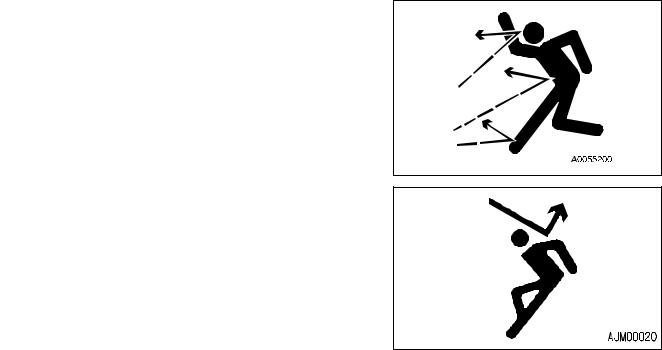
SAFETY |
SAFETY INFORMATION |
|
|
FALLING OBJECTS, FLYING OBJECTS AND INTRUDING OBJECTS PREVENTION
On jobsites where there is a hazard that falling objects, flying objects, or intruding objects may hit or enter the operator's cab, consider the operating conditions and install the necessary guards to protect the operator.

 When carrying out demolition or breaker operations, install a front guard and use a laminated coating sheet on the front glass.
When carrying out demolition or breaker operations, install a front guard and use a laminated coating sheet on the front glass.

 When working in mines or quarries where there is a hazard of falling rock, install FOPS (Falling Objects Protective Structure) and a front guard, and use a laminated coating sheet on the front glass.
When working in mines or quarries where there is a hazard of falling rock, install FOPS (Falling Objects Protective Structure) and a front guard, and use a laminated coating sheet on the front glass.

 When carrying out the above operations, always close the front window. In addition, always ensure that by standers are a safe distance away and are not in hazard from falling or flying objects.
When carrying out the above operations, always close the front window. In addition, always ensure that by standers are a safe distance away and are not in hazard from falling or flying objects.

 The above recommendations assume that the conditions are for standard operations, but it may be necessary to add additional guards according to the operating conditions on the jobsite. Always contact your Komatsu distributor for advice.
The above recommendations assume that the conditions are for standard operations, but it may be necessary to add additional guards according to the operating conditions on the jobsite. Always contact your Komatsu distributor for advice.
CAUTIONS RELATED TO ROPS (ROLLOVER PROTECTION SYSTEM)
 ROPS is a structure designed to protect an operator who is wearing a seatbelt if the machine should roll over. It supports the weight of the machine when it rolls over and also absorbs the impact energy.
ROPS is a structure designed to protect an operator who is wearing a seatbelt if the machine should roll over. It supports the weight of the machine when it rolls over and also absorbs the impact energy.
 If ROPS is modified, its strength may be reduced. When modifying, consult your Komatsu distributor.
If ROPS is modified, its strength may be reduced. When modifying, consult your Komatsu distributor.
 If ROPS is damaged or deformed by falling objects or by rolling over, its strength will be reduced and it will not be able to fulfill its function properly. In such cases, always Komatsu contact your distributor for advice of the method of repair.
If ROPS is damaged or deformed by falling objects or by rolling over, its strength will be reduced and it will not be able to fulfill its function properly. In such cases, always Komatsu contact your distributor for advice of the method of repair.
Even if ROPS is installed, always fasten your seat belt properly when operating the machine. If you do not use your fasten your seat belt properly, it cannot display its effect.
Prohibition of removal of ROPS canopy
 Never remove the ROPS canopy under any circumstances. If the machine should roll over, this will lead to to serious personal injury.
Never remove the ROPS canopy under any circumstances. If the machine should roll over, this will lead to to serious personal injury.
 When removing the ROPS canopy for transportation or any other reason, always consult your Komatsu distributor beforehand.
When removing the ROPS canopy for transportation or any other reason, always consult your Komatsu distributor beforehand.
2 - 15
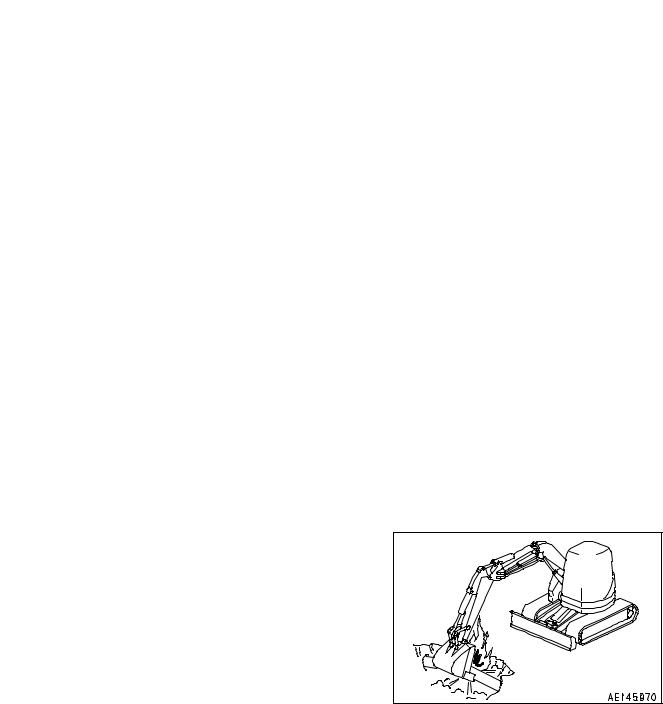
SAFETY INFORMATION |
SAFETY |
|
|
ATTACHMENT INSTALLATION

 When installing optional parts or attachments, there may be problems with safety or legal restrictions. Therefore contact your Komatsu distributor for advice.
When installing optional parts or attachments, there may be problems with safety or legal restrictions. Therefore contact your Komatsu distributor for advice.

 Any injuries, accidents, or product failures resulting from the use of unauthorized attachments or parts will not be the responsibility of Komatsu.
Any injuries, accidents, or product failures resulting from the use of unauthorized attachments or parts will not be the responsibility of Komatsu.

 When installing and using optional attachments, read the instruction manual for the attachment, and the general information related to attachments in this manual.
When installing and using optional attachments, read the instruction manual for the attachment, and the general information related to attachments in this manual.
ATTACHMENT COMBINATIONS
Depending on the type or combination of work equipment, there is a hazard that the work equipment may hit the cab or other parts of the machine. Before using unfamiliar work equipment, check if there is any hazard of interference, and operate with caution.
CAB WINDOW GLASSES
If the cab glass on the work equipment side is broken, there is a hazard that the work equipment may contact the operator's body directly. Stop operation immediately and replace the glass.
UNAUTHORIZED MODIFICATIONS
Any modification made without authorization from Komatsu can create hazards. Before making a modification, consult your Komatsu distributor.

 Komatsu will not be responsible for any injuries, accidents, product failures or other property damages resulting from modifications made without authorization from Komatsu.
Komatsu will not be responsible for any injuries, accidents, product failures or other property damages resulting from modifications made without authorization from Komatsu.
SAFETY AT JOBSITE
Before starting operations, thoroughly check the area for any unusual conditions that could be dangerous.

 When carrying out operations near combustible materials such as thatched roofs, dry leaves or dry grass, there is a hazard of fire, so be careful when operating.
When carrying out operations near combustible materials such as thatched roofs, dry leaves or dry grass, there is a hazard of fire, so be careful when operating.

 Check the terrain and condition of the ground at the worksite, and determine the safest method of operation. Do not carry out operations at places where there is a hazard of landslides or falling rocks.
Check the terrain and condition of the ground at the worksite, and determine the safest method of operation. Do not carry out operations at places where there is a hazard of landslides or falling rocks.
 If water lines, gas lines, or high-voltage electrical lines may be buried under the worksite, contact each utility and identify their locations. Be careful not to sever or damage any of these lines.
If water lines, gas lines, or high-voltage electrical lines may be buried under the worksite, contact each utility and identify their locations. Be careful not to sever or damage any of these lines.
 Take necessary measures to prevent any unauthorized person from entering the operating area.
Take necessary measures to prevent any unauthorized person from entering the operating area.
 In particular, if you need to operate on a road, protect pedestrian and cars by designating a person for worksite traffic duty or by installing fences around the worksite.
In particular, if you need to operate on a road, protect pedestrian and cars by designating a person for worksite traffic duty or by installing fences around the worksite.
 When traveling or operating in shallow water or on soft ground, check the shape and condition of the bedrock, and the depth and speed of flow of the water before starting operations.
When traveling or operating in shallow water or on soft ground, check the shape and condition of the bedrock, and the depth and speed of flow of the water before starting operations.
WORKING ON LOOSE GROUND
 Avoid traveling or operating your machine too close to the edge of cliffs, overhangs, and deep ditches. The ground may be weak in such areas. If the ground should collapse under the weight or vibration of the machine, there is a hazard that the machine may fall or tip over. Remember that the soil after heavy rain or blasting or after earthquakes is weak in these areas.
Avoid traveling or operating your machine too close to the edge of cliffs, overhangs, and deep ditches. The ground may be weak in such areas. If the ground should collapse under the weight or vibration of the machine, there is a hazard that the machine may fall or tip over. Remember that the soil after heavy rain or blasting or after earthquakes is weak in these areas.
 When working on embankments or near excavated ditches, there is a hazard that the weight and vibration of the machine will cause the soil to collapse. Before starting operations, take steps to ensure that the ground is safe and to prevent the machine from rolling over or falling.
When working on embankments or near excavated ditches, there is a hazard that the weight and vibration of the machine will cause the soil to collapse. Before starting operations, take steps to ensure that the ground is safe and to prevent the machine from rolling over or falling.
2 - 16
